This article reveals all you need to know NECO Biology Questions and Answers 2025 | Essay and Objectives. All NECO candidates for 2025 June/July SSCE should take every information contained in this post very serious.
I have specially prepared this article for the benefit of those who will be writing the 2025 June/July NECO examination. If you are sure that you would be sitting for this examination and biology is one of the subjects that you will be writing, pay close attention to all that you are going to see here.
There is good news for you!
Do wish to the complete NECO biology questions and answers before entering the examination venue/hall? If you have answered yes to this question, then you have to read this article to the end.
I have got EXPO for you on 2025 NECO Biology Questions and answers for Essay and Objectives. Do not leave this page if want to get detailed information about it.
Keep reading!
Download New NECO Timetable For Free Here
- NECO Biology Answers 2025 (EXPO)
- NECO Biology Questions and Answers for 2025 (Essay and Objectives)
- NECO Biology Objective Question for 2025
- NECO Biology Objective Answers for 2025
- NECO Biology Theory Questions for 2025 (Essay)
- NECO Biology Theory Answers for 2025
- More NECO Biology Objective Questions
- NECO Biology Objective Answers to Practice Questions
- More NECO Biology Theory Questions
NECO Biology Answers 2025 (EXPO)
1-10: DDEDBAEACC
11-20: DEECCBBBAB
21-30: EEADEAEAEA
31-40: BCCBCCBADE
41-50: DCCBCBECDC
51-60: EABBCCBADE
(1ai)
(i) Setting up of national park and gardens to save wildlife in their natural environment.
(ii) Poaching i.e. uncontrolled and illegal killing of game should be prevented.
(iii) Avoiding the use of pesticides that may kill off many animals
(vi) Prohibiting deforestation and encouraging afforestation
(1ii)
Sexual reproduction involves the fusion of two gametes – male and female gametes during fertilization to form a zygote which develops into a new organism. It involves organisms of the same species.
Or
Sexual reproduction is the fusion or joining of male and female gametes or nuclei from different individual to form a zygote which later develops into an embryo or organism.
(1aiii)
(i) biceps (flexor)
(ii) Triceps (extensor)
(1b)
– When one touches a hot object, the sensory receptor in the skin receives the stimulus
– An impulse is transmitted from the receptor to the spinal cord, via the dorsal root/sensory neurone
– The intermediate neurone in the spinal cord passes on the impulse to the motor neurone
– The motor neurone then sends the impulses to an effector organ (muscle) via the ventral root
– All the neurones are linked by synapses across which impulses are sent
– The muscle upon receiving the impulse contracts causing the hand to be withdrawn from the hot object
(1ci)
(Pick Any Three)
(i) It provides water for photosynthesis
(ii) To get rid of excess water in the plant
(iii) It helps plants to continually draw water from the soil into their stem and leaves.
(iv) Some evaporation of water uses latent energy from plants and therefore keeps the plant cool
(v) It helps in the transport of mineral salts from soil to leaves and growing points of the plant
(1cii)
(i) Growing of cover crops like grasses, sweet potato which covers the surface of the soil
(ii) Contour ploughing: ploughing along the contours of a slope to reduce the speed of runoff water.
(NUMBER TWO)
(2ai)
Metamorphosis: This is the name given to the change in form shown by insects and amphibians from the egg stage to the adult stage.
(2aii)
(Pick Any Four)
(i) It regulate sex drive (libido)
(ii) It helps in the production of sperm
(iii) It helps in the production of red blood cells
(iv) It is responsible for muscle mass and strength
(v) Cause an increase in bone mass
(vi) Responsible for fat distribution
(2aiii)
(Pick Any Four)
(i) It deaminates excess amino acid to urea
(ii) It stores iron from broken down cells
(iii) It detoxified poisonous substances and sent to the kidney for excretions
(iv) It supplies heat to the body by its metabolic reactions
(v) It also store fats and releases it at controlled rates into the blood when the need arises
(vi) It stores and releases minerals (iron, copper and potassium and vitamins (A, D and B12)
(2bi)
(Pick Any Three)
(i) Oxygen (only in the day)
(ii) Carbon dioxide (only at night)
(iii) Water
(iv) Tannins
(v) Alkaloids
(vi) Resins
(vii) Latex
(viii) Gum
(2bii)
– The semi-circular canals in the inner ear are responsible for the maintenance of balance with respect to circular motion.
– There are three semi-circular canals and each is found in one of the geometrical planes (right angle to each other)
– During spinning, the gelatinous cupula in one of the semi-circular canals is set in motion.
– This stimulates the sensory hairs, and impulses are sent through the auditory nerves to the brain for proper body posture.
– When one stops spinning, the gelatinous cupula does not stop moving instantly but continues to move for some time
– This cause the continue feeling of the sensation of spinning
(3ai)
(i)Buccal respiration
(ii)Lung respiration
(iii)Skin respiration
(3aii)
TABULATE PLEASE
=WIND POLLINATED FLOWERS=
(i) The flowers are not attractive
(ii) The pollen grains are not sticky
=INSECT POLLINATED FLOWERS=
(i) The flowers are attractive
(ii) The pollen grains are sticky
(3aiii)
(i)Parietal placentation.
(ii) Basal placentation.
(3bi)
Light rays from an external object is refracted by the cornea, aqueous humour, the lens and the vitreous humour. The lens act as the fine adjustment bringing the rays to a focus on the retina. The image formed on the retina of human are inverted and diminished. The brain receives the stimulus via the optic nerves and then interprete it.
(3bii)
(i)Parasitic nutrition
(ii)Symbiosis
(iii)Carnivorous nutrition
4(ai)

(4aii)
(i) Internal fertilization
(ii) External fertilization
(4bi)
– After fertilization, the zygote divides repeatedly and develops into an embryo which consists of the plumule, radicle and one or two cotyledons.
– The primary endosperm nucleus develops into a nutritive tissue called endosperm, which stores food used by the developing embryo
– The synergids and the antipodal cells degenerate
– The ovule changes to form the seed and the interguments form the seed coat
– The micropyle remains where air and water enter the seed.
– The ovary develop into the fruit and the ovary wall forms the fruit wall called the pericarp.
– The style shrivels off, the petals, sepals and the stamens wither and fall off
(4bii)
(i) Red blood cells
(ii) White blood cells
(iii) Blood plasma
(iv) Platelets
(5ai)
(i)They are proteinous in nature
(ii) They speed up the rate of chemical reaction
(iii) They are organic catalyst
(iv) They are specific in function
(5aii)
Mendel’s first law also known as the law of segregation of genes states that during gamete formation, two alleles at a gene locus segregate from each other and each gamete has an equal probability of containing either allele
NECO Biology Questions and Answers for 2025 (Essay and Objectives)
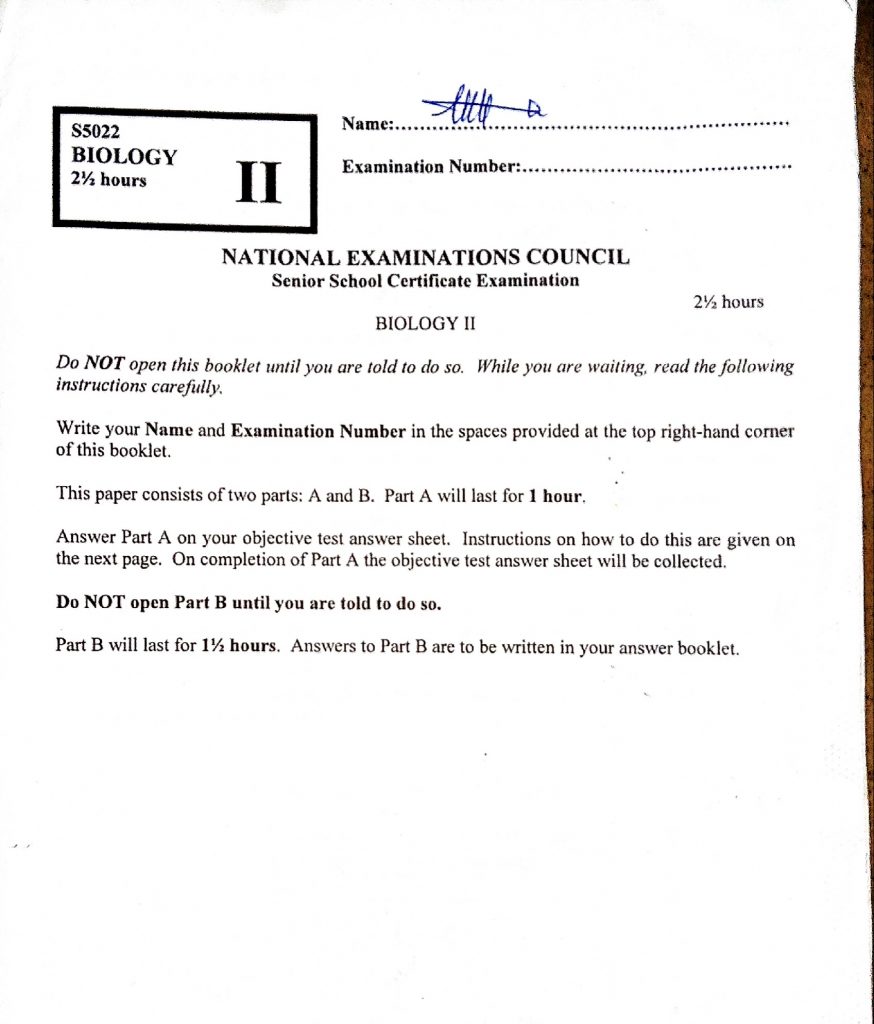
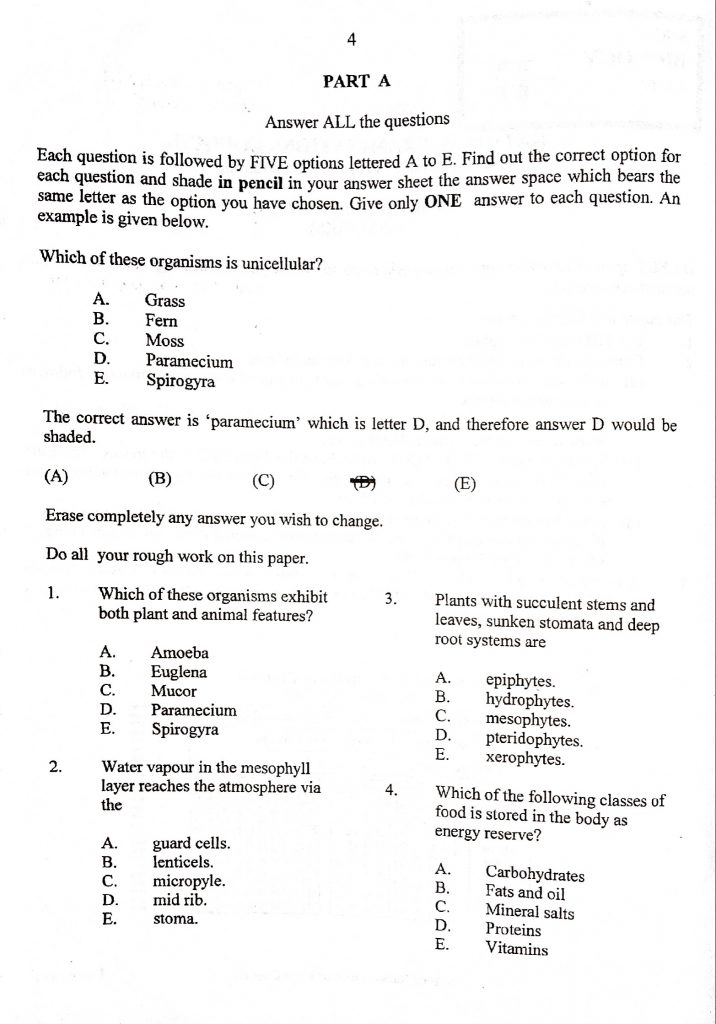
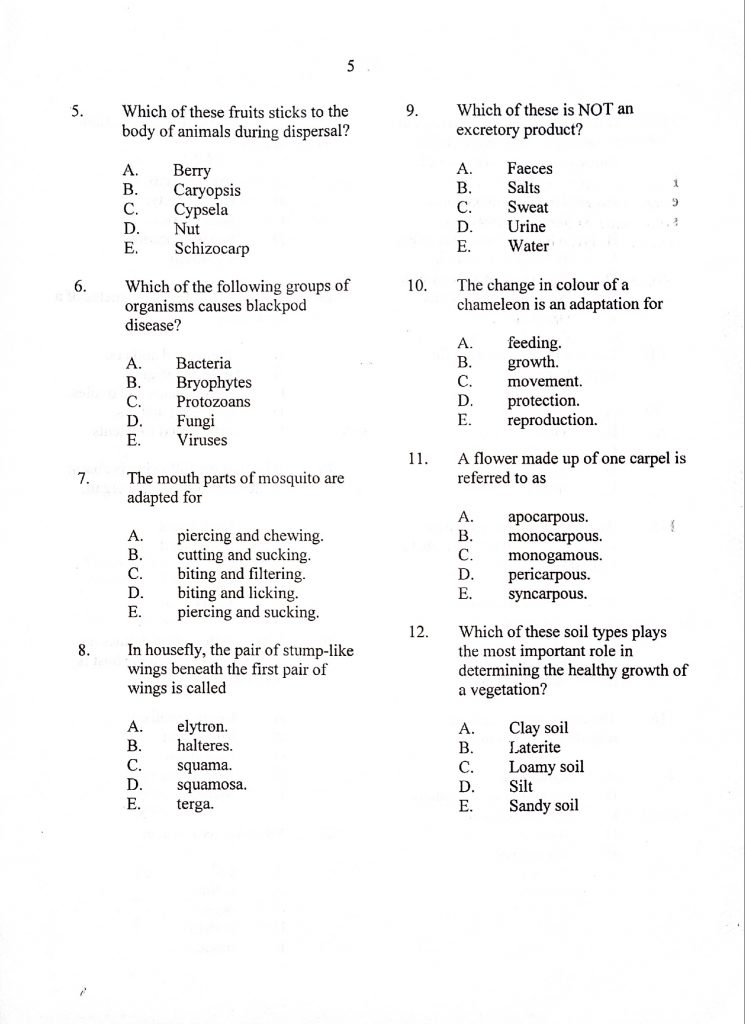
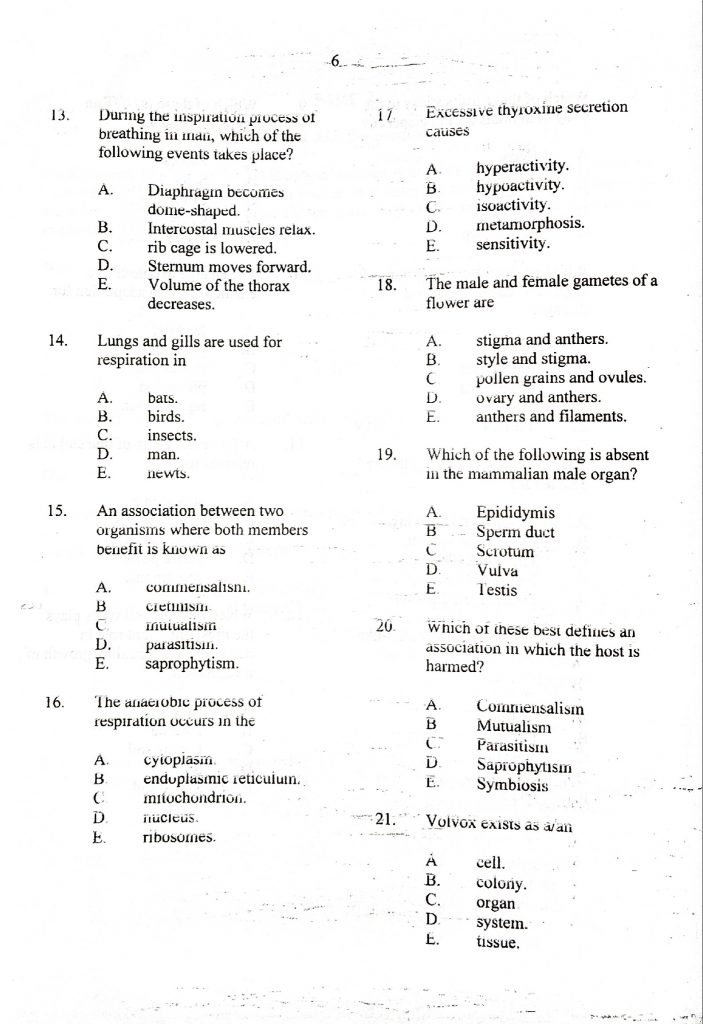
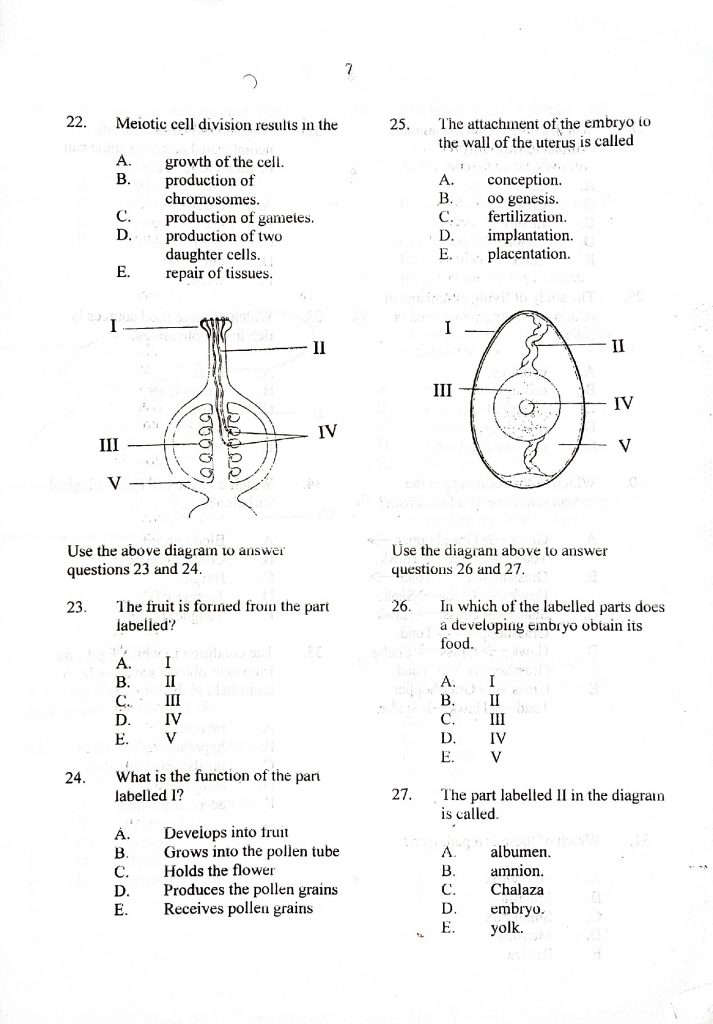

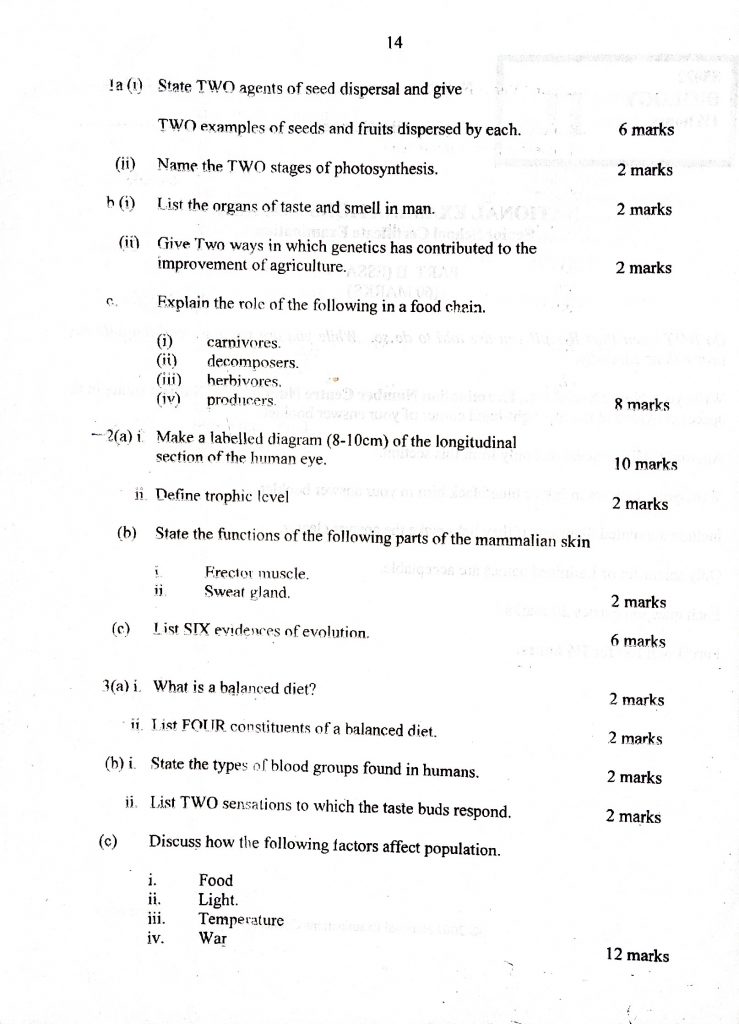
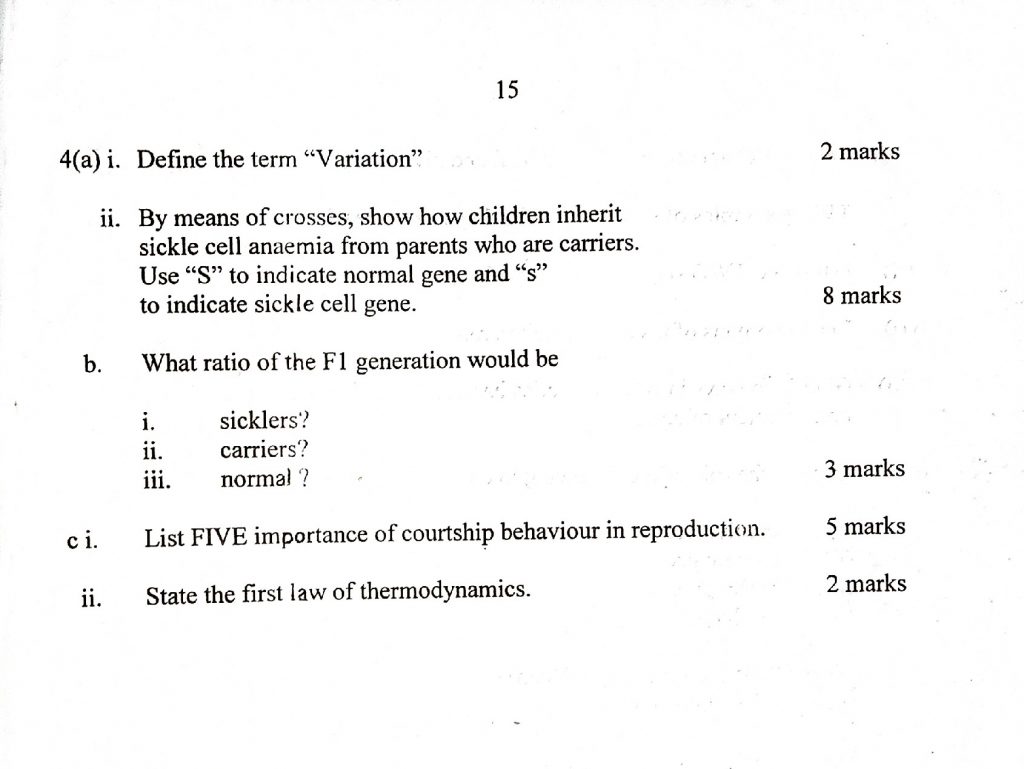
Trending Posts:
NECO Biology Practical Specimen, Questions And Answers 2025 | Complete Specimen And Solutions
NECO Civic Education Questions And Answers 2025 | Theories And Objectives
NECO History Questions And Answers 2025 | Essay And Objectives
NECO Home Management Questions And Answers 2025 | Essay And Objectives
NECO Mathematics Questions And Answers For 2025 | Theories And Objectives
NECO Agric Questions And Answers 2025 | Essay And Objectives
NECO Marketing Questions And Answers 2025 | Theories & Objectives
NECO Biology Objective Question for 2025
In this section, I will start by showing you all the questions that you should expect in your NECO biology objective questions for 2025.
Candidates should note that all the questions given in this section are predictions that are likely going to be true about NECO 2025.
Instructions
Each question is followed by FIVE options lettered A to E.
Find out the correct option for each question and shade in pencil in your answer sheet the answer space which bears the same letter as the option you have chosen.
Give only ONE answer to each question. An example is given below.
Which of these organisms is unicellular?
A. Grass
B. Fern
C. Moss
D. Paramecium
E. Spirogyra
The correct answer is ‘paramecium’ which is letter D, and therefore answer D would be shaded.
(A) (B) (C) (D) (E)
Erase completely any answer you wish to change.
Do all your rough work on this paper.
1. Which of these organisms exhibit both plant and animal features?
A. Amoeba
B. Euglena
C. Mucor
D. Paramecium
E. Spirogyra
2. Water vapour in the mesophyll layer reaches the atmosphere via the
A. guard cells.
B. lenticels.
C. micropyle.
D. mid rib.
E. stoma
3. Plants with succulent stems and root systems are leaves, sunken stomata and deep
A. epiphytes.
B. hydrophytes.
C. mesophytes.
D. pteridophytes.
E. xerophytes.
4. Which of the following classes of food is stored in the body as energy reserve?
A. Carbohydrates
B. Fats and oil
C. Mineral salts
D. Proteins
E. Vitamins
5. Which of these fruits sticks to the body of animals during dispersal?
A. Berry
B. Caryopsis
C. Cypsela
D. Nut
E. Schizocarp
See also: NECO Government Questions and Answers for 2025
6. Which of the following groups of organisms causes blackpod disease?
A. Bacteria
B. Bryophytes
C. Protozoans
D. Fungi
E. Viruses
7. The mouth parts of mosquito are adapted for
A. piercing and chewing.
B. cutting and sucking
C. biting and filtering.
D. biting and licking.
E. piercing and sucking.
8. In housefly, the pair of stump-like wings beneath the first pair of wings is called
A. elytron.
B. halteres
C. squama
D. squamosa
E. terga.
9. Which of these is NOT an excretory product?
A. Faeces
B. Salts
C. Sweat
D. Urine
E. Water
10. The change in colour of a chameleon is an adaptation for
A. feeding.
B. growth.
C. movement.
D. protection.
E. reproduction.
11. A flower made up of one carpel is referred to as
A. apocarpous.
B. monocarpous.
C. monogamous.
D. pericarpous.
E. syncarpous.
12. Which of these soil types plays the most important role in determining the healthy growth of a vegetation?
A. Clay soil
B. Laterite
C. Loamy soil
D. Silt
E. Sandy soil
13. During the inspiration process of breathing in man, which of the following events takes place?
A. Diaphragm becomes dome-shaped.
B. Intercostal muscles relax.
C. rib cage is lowered.
D. Sternum moves forward.
E. Volume of the thorax decreases.
14. Lungs and gills are used for respiration in
A. bats.
B. birds.
C. insects.
D. man
E. newts
15. An association between two organisms where both members benefit is known as
A. commensalism.
B. Cretinism
C. mutualism
D. parasitism
E. saprophytism.
16. The anaerobic process of respiration occurs in the
A. cytoplasm
B. endoplasmic reticulum.
C. mitochondrion.
D. nucleus
E. ribosomes.
17. Excessive thyroxine secretion causes
A. hyperactivity.
B. hypoactivity.
C. isoactivity.
D. metamorphosis.
E. sensitivity.
18. The male and female gametes of a flower are
A. stigma and anthers.
B. style and stigma.
C. pollen grains and ovules.
D. Ovary and anthers.
E. anthers and filaments.
19. Which of the following is absent in the mammalian male organ?
A. Epididymis
B. Sperm duct
C. Scrotum
D. Vulva
E. Testis
20. Which of these best defines an association in which the host is harmed?
A. Commensalism
B. Mutualism
C. Parasitism
D. Saprophytism
E. Symbiosis
21. Volvox exists as a/an
A. cell.
B. colony.
C. organ
D. system.
E. tissue.
22. Meiotic cell division results in the
A. growth of the cell.
B. production of chromosomes.
C. production of gametes.
D. production of two daughter cells.
E. repair of tissues.
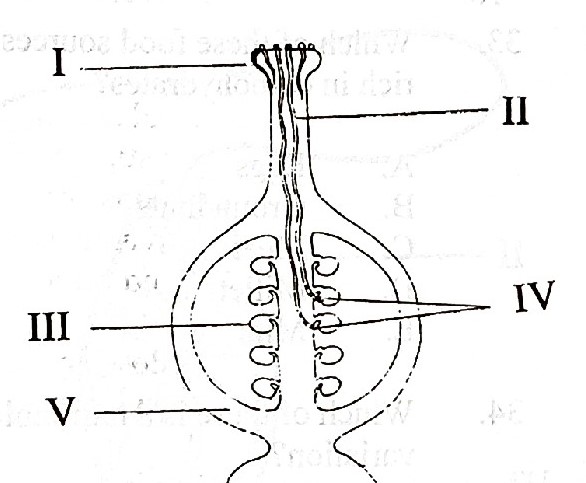
Use the above diagram to answer questions 23 and 24.
23. The fruit is formed from the part labelled?
A. I
B. II
C. III
D. IV
E. V
24. What is the function of the part labelled I?
A. Develops into fruit
B. Grows into the pollen tube
C. Holds the flower
D. Produces the pollen grains
E. Receives pollen grains
25. The attachment of the embryo to the wall of the uterus is called
A. conception.
B. oogenesis.
C. fertilization.
D. implantation.
E. placentation.

Use the diagram above to answer questions 26 and 27.
26. In which of the labelled parts does a developing embryo obtain its food.
A. I
B. II
C. III
D. IV
E. V
27. The part labelled II in the diagram is called.
A. albumen.
B. amnion.
C. Chalaza
D. embryo.
E. yolk.
28. Which of the following animals exhibits territoriality?
A. Bat
B. Cow
C. Lizard
D. Rabbit
E. Toad
29. The study of living organisms in relation to their environment is called
A. cytology.
B. ecology.
C. haemotology.
D. mycology.
E. paleontology.
30. Which of the following is the correct sequence of a food chain?
A. Grass →Grasshopper →Toad →Snake →Hawk.
B. Grasshopper →Toad →Hawk →Grass →Snake.
C. Snake →Grass →Hawk →Grasshopper →Toad.
D. Hawk →Grass →Snake →Grasshopper →Toad.
E. Grass →Grasshopper →Toad →Hawk →Snake.
31. Which of these is a pathogen?
A. HIV virus
B. Malaria
C. Small pox
D. Measles
E. Rabies
32. A bone with large centrum, neural canal and long spine can be found around the
A. chest.
B. neck.
C. skull.
D. tail.
E. waist.
33. Which of these food sources is rich in carbohydrates?
A. Eggs
B. Groundnuts
C. Meat
D. Millet
E. Milk
34. Which of these is a morphological variation?
A. Blood groups
B. Colour blindness
C. Height
D. Tasting PTC
E. Tongue rolling
35. The condition in which light rays from near objects are brought to focus behind the retina is
A. myopia.
B. hypermetropia.
C. presbyopia.
D. astigmatism.
E. accommodation.
36. The two digestive enzymes that work in an acid medium are
A. amylase and pepsin.
B. lipase and renin.
C. maltase and erepsin.
D. pepsin and renin.
E. trypsin and lipase.

Study the diagram above and use it to answer questions 37 and 38.
37. In the diagram above, the part labelled II is called
A. contractile vacuole.
B. cytoplasm
C. eyespot.
D. photoreceptor.
E. flagellum.
38. The function of the part labelled III in the diagram is to
A. absorb water from the surrounding.
B. control the activities of the cell.
C. manufacture food.
D. move the organism.
E. store waste products.
39. The part of the nervous system which controls voluntary actions is the
A. cerebellum.
B. cerebrum.
C. medulla oblongata.
D. spinal cord.
E. thalamus.
40. Which of these insects undergoes incomplete metamorphosis?
A. Beetle
B. Butterfly
C. Cockroach
D. Housefly
E. Mosquito
41. Which of the following blood groups is a universal recipient?
A. A
B. B
C. AB
D. O
E. AO
42. A little food substance in a test tube plus millon’s reagent when heated, tests for the presence of
A. Fats and oil.
B. Simple sugars.
C. Starch.
D. Mineral salts.
E. Protein.
43. A child produced from the mating between mother and son (as in goats) is an example of
A. asexual reproduction.
B. cross-breeding.
C. in breeding.
D. out breeding.
E. self-fertilization.
44. The hereditary material controlling a particular trait in organisms is called
A. centrosome.
B. chromatid.
C. chromosome.
D. gene.
E. lysosome.
45. Which of these causes competition in a habitat?
A. Abundance of food.
B. Drought and adverse weather
C. High photosynthetic activities
D. Increase in population
E. Moderate rainfall and temperature
46. Which of these methods is a modern way of food preservations?
A. Drying
B. Frying
C. Refrigeration
D. Salting
E. Smoking
47. The association existing between tapeworm and man is
A. holozoic.
B. parasitic.
C. predatory.
D. saprophytic.
E. symbiotic.
48. Sex-linked traits are
A. carried by genes on sex chromosomes.
B. carried by genes on autosomes.
C. most often x-linked.
D. mostly transferred from mother to offspring.
E. often recessive in nature.
49. Which of the following defines a climax community?
A. A stable stage in the succession of organisms
B. A series of changes in the population of organisms
C. Highest attainable stage in species composition
D. A community that changes only when a habitat factor changes
E. The composition and size are the same over a long period of time
50. If a young couple is found to be carriers of baldhead trait, what is the probability that their first child would be baldheaded?
A. 1/4
B. 1/3
C. 2/3
D. 1/2
E. 3/4
Use the diagram below to answer questions 51 and 52.

51. Which of the following indicates the direction of movement of sperm introduced into the female reproductive organ.
A. II →I →IV →V
B. III →II →I →IV
C. VI →V →III →II
D. VI→IV →III →II
E. VI →IV →II →I
52. Where does fertilization take place?
A. VI
B. V
C. IV
D. II
E. I
53. Infertility in females may be as a result of
A. hairs on the body
B. lack of ovulation.
C. menstrual cycle.
D. narrow pelvis.
E. small breasts.
54. In which of the following parts of plants can auxins be found in highest concentration?
A. Flower
B. Lenticel
C. Mid rib
D. Petiole
E. Shoot apex
55. Which of these animals possesses an exoskeleton?
A. Earthworm.
B. Obelia.
C. Spider
D. Starfish.
E Tapeworm.
56. The central nervous system is made up of which of the following pairs?
A. Brain and spinal cord.
B. Brain and nerves
C. Spinal cord and Sympathetic nervous system
D. Parasympathetic and sympathetic nervous systems.
E. Brain and Cerebrum
57. Which of the following is an autotrophic mode of nutrition?
A. Holozoic
B. Parasitic
C. Photosynthesis
D. Saprophytic
E. Symbiotic
58. For an organism to survive changes in its environment, it must
A. absorb more water.
B. adapt to the new conditions.
C. find shelter.
D. obtain more food.
E. obtain more light.
59. Which of these cell organelles is associated with energy generation?
A. Chloroplast
B. Endoplasmic reticulum
C. Golgi apparatus
D. Mitochondrion
E. Ribosome
60. In hypogeal germination, the
A. cotyledons are beneath the ground.
B. cotyledons are above the ground.
C. Epicotyl is beneath the ground.
D. Hypocotyl is above the ground.
E. Hypocotyl and cotyledons are above the ground.
NECO Biology Objective Answers for 2025
The table below shows a complete answers to NECO Biology objective questions for the 2025 examination:
| 1 | B | 21 | B | 41 | E |
| 2 | E | 22 | C | 42 | E |
| 3 | E | 23 | C | 43 | C |
| 4 | B | 24 | E | 44 | D |
| 5 | B | 25 | E | 45 | D |
| 6 | D | 26 | C | 46 | C |
| 7 | E | 27 | C | 47 | E |
| 8 | B | 28 | C | 48 | D |
| 9 | A | 29 | B | 49 | E |
| 10 | D | 30 | A | 50 | |
| 11 | B | 31 | A | 51 | |
| 12 | C | 32 | E | 52 | |
| 13 | D | 33 | D | 53 | |
| 14 | E | 34 | C | 54 | |
| 15 | C | 35 | B | 55 | |
| 16 | A | 36 | D | 56 | |
| 17 | A | 37 | C | 57 | |
| 18 | E | 38 | C | 58 | |
| 19 | D | 39 | A | 59 | |
| 20 | C | 40 | C | 60 |
More of the answers to the objective question shall posted shortly. Keep checking this site for timely updates.
NECO Biology Theory Questions for 2025 (Essay)
The following are the questions that you should expect in you NECO Biology theory questions for 2025 June/July examinations:
1a (1) State TWO agents of seed dispersal and give:
TWO examples of seeds and fruits dispersed by each. 6 marks
(ii) Name the TWO stages of photosynthesis. 2 marks
b (1) List the organs of taste and smell in man. 2 marks
(ii) Give Two ways in which genetics has contributed to the improvement of agriculture. 2 marks
c. Explain the role of the following in a food chain.
(i) carnivores.
(ii) decomposers.
(iii) herbivores.
(iv) producers.
8 marks
2(a) i Make a labelled diagram (8-10cm) of the longitudinal section of the human eye. 10 marks
ii. Define trophic level
2 marks
(b) State the functions of the following parts of the mammalian skin
(i) Erector muscle.
(ii) Sweat gland.
2 marks
(c) List SIX evidences of evolution. 6 marks
3(a) i. What is a balanced diet? 2 marks
ii. List FOUR constituents of a balanced diet.
2 marks
(b) i State the types of blood groups found in humans.
2 marks
ii. List TWO sensations to which the taste buds respond.
(c) Discuss how the following factors affect population.
i. Food
ii. Light.
iii. Temperature
iv. War
12 marks
4(a) i. Define the term “Variation”
2 marks
ii. By means of crosses, show how children inherit sickle cell anaemia from parents who are carriers. Use “S” to indicate normal gene and “s” to indicate sickle cell gene.
8 marks
b. What ratio of the F1 generation would be
i. sicklers?
ii. carriers?
iii. normal?
3 marks
(C) i. List FIVE importance of courtship behaviour in reproduction.
5 marks
ii. State the first law of thermodynamics.
2 marks
NECO Biology Theory Answers for 2025
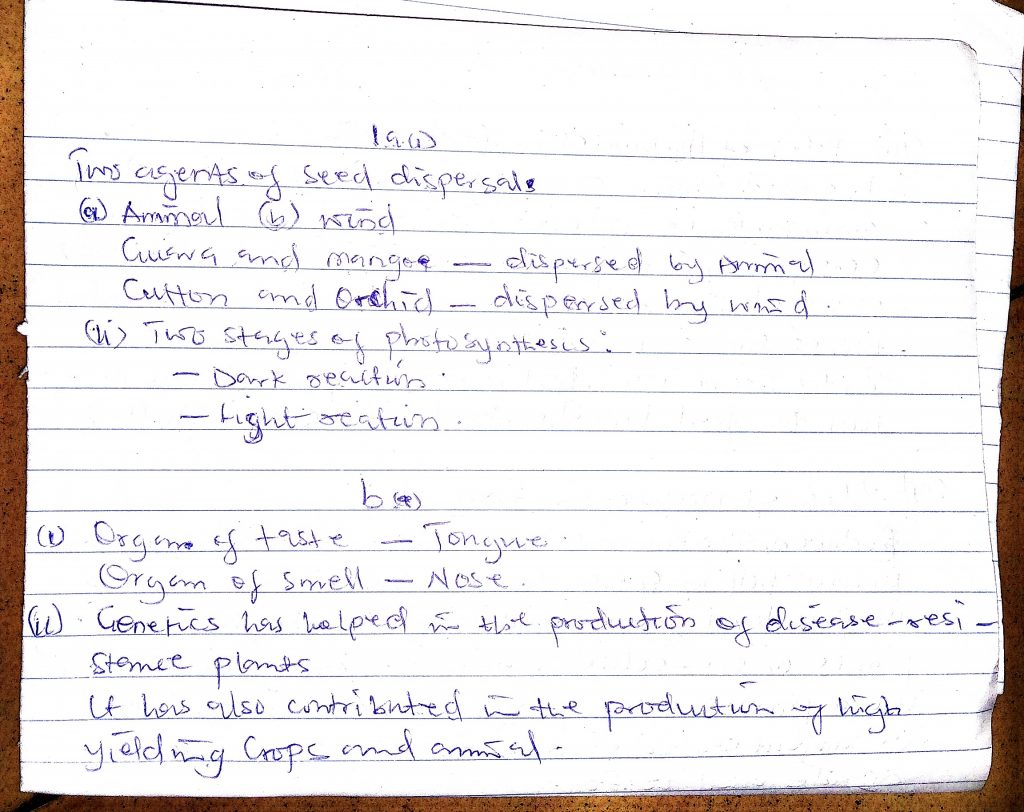
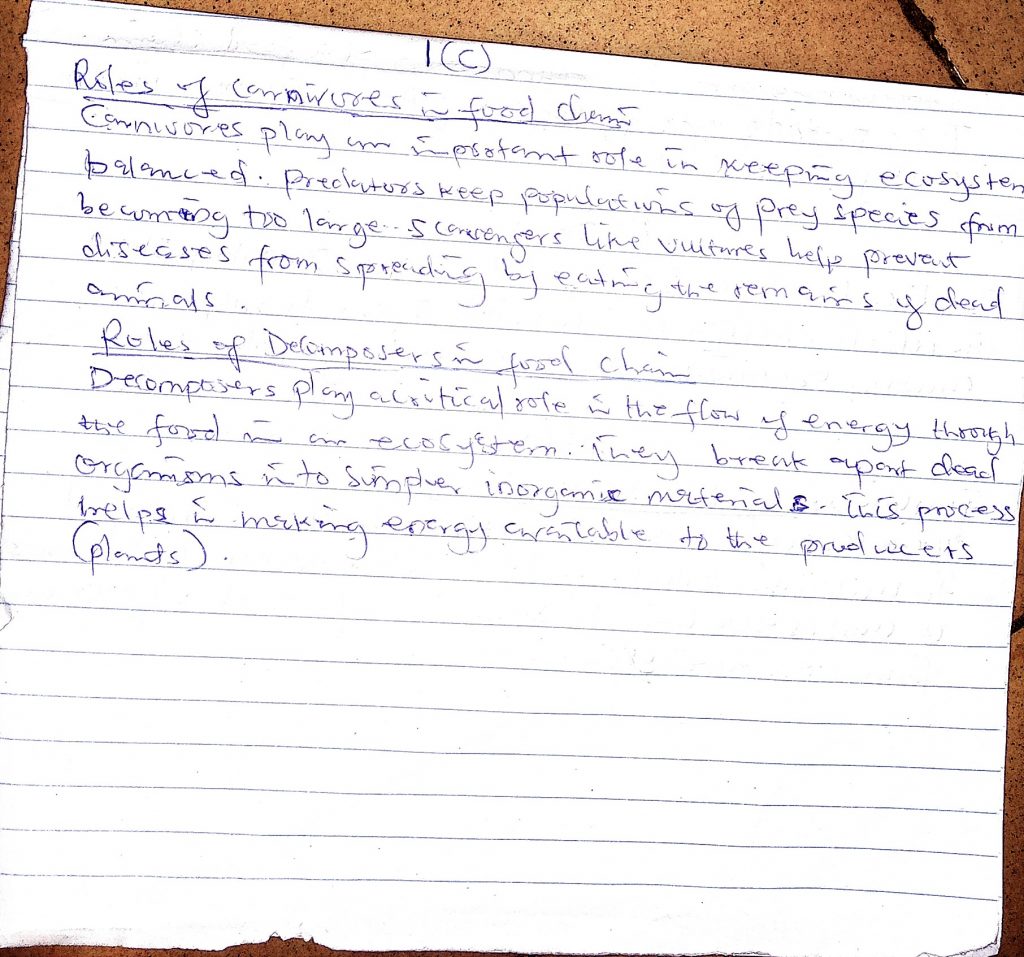
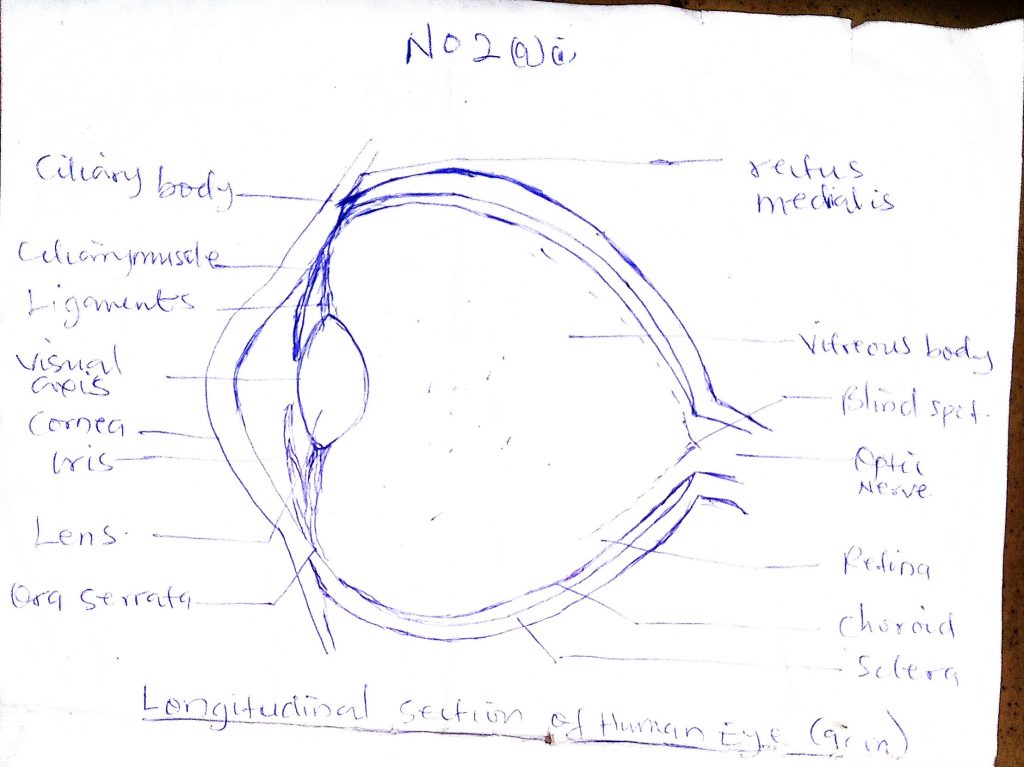
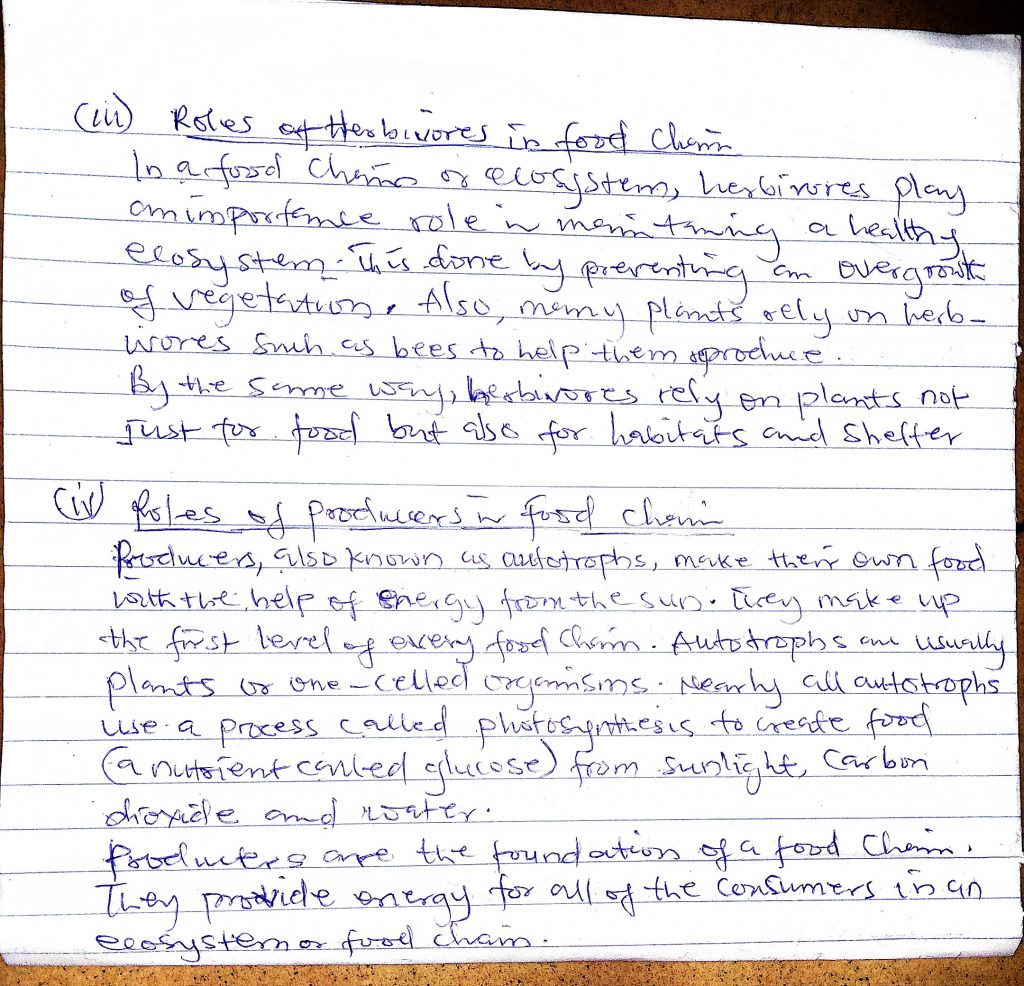
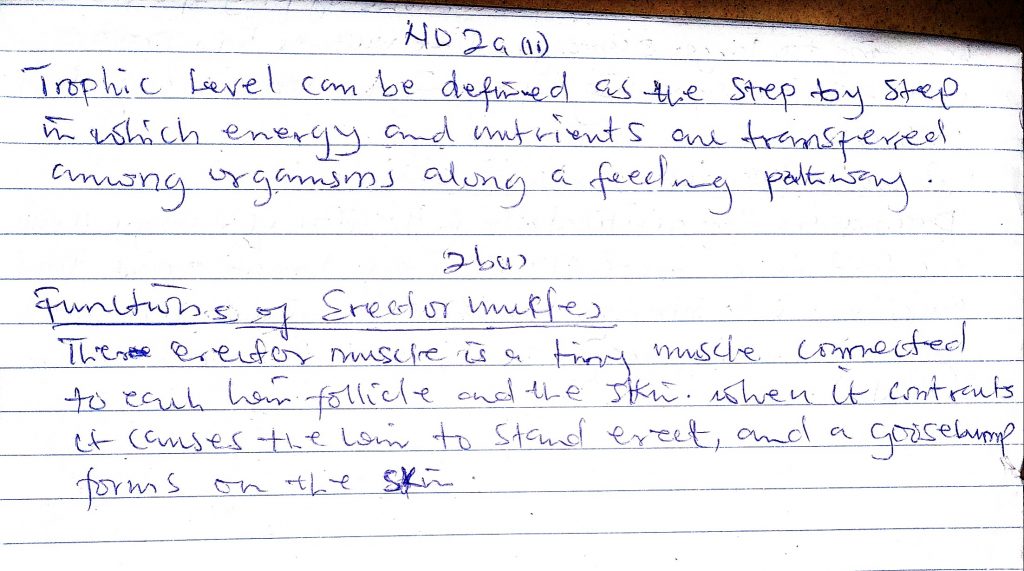
.1a
(i) Two agents of seed dispersal:
(1) Man
(2) Wind
Guava and mango – dispersed by animal
Cotton and Orchid – dispersed by wind
(ii) two stage of photosynthesis are:
Dark reaction
Light reaction
1b (i)
Organ of taste – Tongue
Organ of smell – Nose
(ii) Genetics has helped in the production of disease-resistant plants.
It has also contributed in the production of high-yielding crops and animals.
1c
Roles of Carnivores in Food Chain
Carnivores play an important role in keeping ecosystem balanced. Predators keep population of prey species from becoming too large. Scavengers like vultures help to prevent diseases from spreading by eating the remains of dead animals.
Roles of Decomposers in Food Chain
Decomposers play a critical role in the flow energy through the food chain in an ecosystem. They break dead organisms apart into smaller inorganic materials. This process helps in making energy available to the producers (plants).

Roles of Herbivores in Food Chain
In a food chain or an ecosystem, herbivores play important role in maintaining a healthy ecosystem. This is done by preventing an overgrowth of vegetation.
Also, many plants rely on the herbivores such as bees and butterfly to help them reproduce.
Roles of Producers in Food Chain
Producers, also known as Autotrophs, make their own food with the help of energy from the sun. they make up the first level of every food chain.
Autotrophs are usually plants or one-celled organisms. Nearly all autotrophs use a process called photosynthesis to create food (a nutrient called glucose) from sunlight, carbon dioxide and water.
Producers are the foundation of a food chain. They provide energy for all of the consumers in an ecosystem or food chain.
No2a
.i) Trophic level can be defined as the step by step in which energy and nutrients are transferred among organisms along a feeding pathway called food chain
2c.
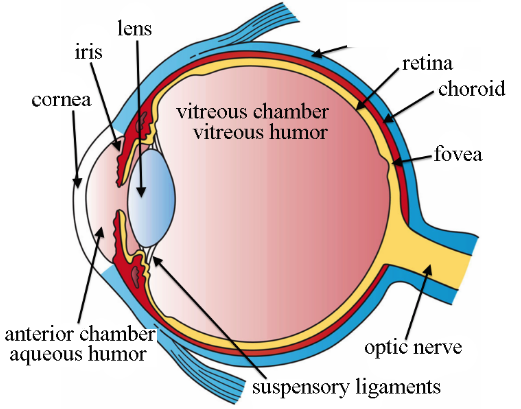
2b)
.i) Functions of Erector Muscles
The erector muscle is a tiny muscle connected to each hair follicle and the skin. When it contracts, it causes the hair to stand erect and Goosebumps forms on the skin.
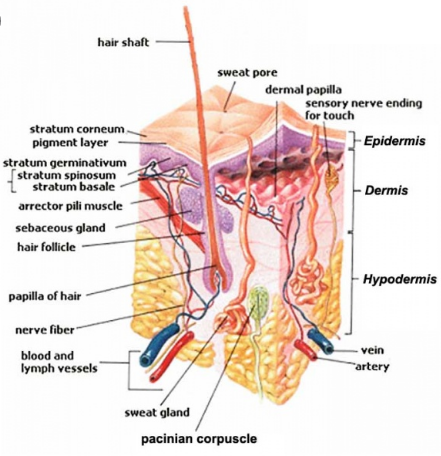
……………………………………………………………
Do wish to see more of the theory answers?
All you have to do is to keep visiting this page regularly as the complete answers to the question shall be uploaded as soon as possible.
Keep following this article to the end!
More NECO Biology Objective Questions
Answer all the questions.
Each question is followed by four options lettered A to D. Find out the correct option for each question and shade in pencil on your answer sheet, the answer space which bears the same letter as the option you have chosen. Give only one answer to each question. An example is given below.
Which part of the gill of fish is involved in gaseous exchange?
A. Gill slits
B. Gill bars
C. Gill covers
D. Gill filaments
The correct answer is Gill filaments, which is lettered D and therefore answer space D would be shaded.
[A] [B] [C] [D]
Think carefully before you shade the answer spaces; erase completely any answer you wish to change.
Do all rough work on this question paper.
Now answer the following questions.
- Which of the following organisms is not classified as an animal?
A. Amoeba
B. Paramecium
C. Euglena
D. Obelia
2. An organism that operates at the cellular level of organization, carries out its physiological activities by using its
A. cell membrane.
B. organelles.
C. small size.
D. cytoplasm.
3. The organelle which eliminates water from the body of a protozoan is the
A. plasma membrane.
B. contractile vacuole.
C. nucleus.
D. cell wall.
4. Which of the following cell types has the least number of mitochondria?
A. Cardiac cells of the heart
B Cells of the cornified layer
C. Muscle cells of the bladder
D. Muscle cells of the diaphragm
5. A typical plant cell is mainly distinguished from an animal cell by the possession of
A. chloroplast and nucleus.
B. cell wall and cytoplasm.
C. chloroplast and cell wall.
D. cell wall and mitochondrion.
6. Which of the following characteristics do fungi share in common with animals?”
A. Presence of digestive tract
B. Movement from one place to another.
C. Storage of carbohydrate as glycogen
D. Movement of centrioles during cell division
7. Which of the following processes involves diffusion?
A. Opening and closing of stomatal pores
B. Turgidity of herbaceous plants
C. Absorption of water through the root hairs
D. Absorption of digested food into the villi
8. The mechanism of opening and closing of stomata in plants is based on
A. turgidity and diffusion.
B. turgidity and flaccidity.
C. osmosis and diffusion.
D. diffusion and flaccidity.
9. In cellular respiration energy is made available to organisms by
A. removal of a phosphate group from ADP.
B. breaking off a phosphate group from ATP.
C. adding a phosphate group to glucose.
D. breaking off a hydrogen ion from NADPH.
10. Excretion in Paramecium sp. is by diffusion because
A. its habitat is water and moist places.
B. it has simple, small and few internal organs.
C. it has a large surface area to volume ratio.
D. it has a large efficient meganucleus.
11. The axial skeleton is composed of the
A. skull and vertebral column.
B. limbs and girdles.
C. atlas and axis.
D. radius and ulna.
12. The inorganic components of bone consist of
A. magnesium, sodium and calcium.
B. magnesium, phosphorus and calcium.
C. sodium, phosphorus and calcium.
D. potassium, magnesium and calcium.
13. A pulse is best described as
A. contraction of arteries to let out blood.
B. contraction of veins to allow blood into them.
C. dilation of arteries to accommodate blood rushing through.
D. pumping action of the heart to move blood round the body.
14. The following characteristics are associated with the mammalian lungs except
A. large surface area.
B. expandable lungs.
C. moist surface.
D. highly vascularized.
15. The excretory system in mammals consists of the following parts except
A. two kidneys.
B. two ureters.
C. two bladders.
D. one urethra.
16. The organ that receives reduced flow of blood during vigorous exercise is the
A. brain.
B. heart.
C. lung.
D. limb.
17. The car pinna is strengthened by
A. blood pressure.
B. cartilage.
C. bone.
D. turgor pressure.
18. The relationship between the retina and the brain is similar to that between the
A. cochlea and the auditory nerve.
B. cochlea and the brain.
C. cochlea and the semi-circular canals.
D. eardrum and the brain.
19. Which of the following statements about the development of the foetus is not correct?
A. The circulatory system of the foetus is directly connected to the maternal blood vessels.
B. The foetus depends on the mother’s blood for its food and oxygen. C. The foetus is surrounded by a water sac.
D. Food and oxygen are carried across the placenta to the embryo’s blood.
Use the diagram below to answer questions 20 and 21.
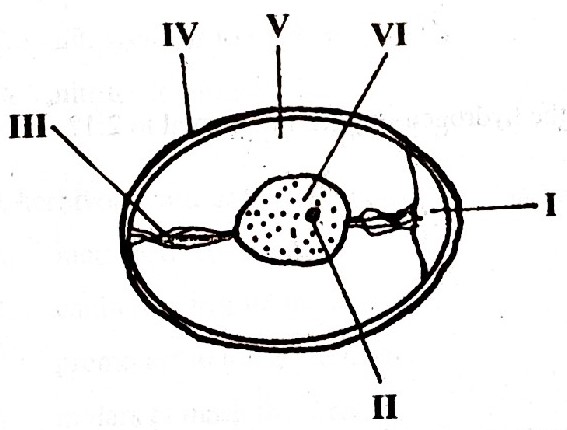
20. The parts that supply food and water to the developing embryo are labelled
A. I and II.
B. III and V.
C. V and VI.
D. II and III.
21. The part labelled III
A. albumen.
B chalaza.
C. yolk.
D. air space.
22. Which of the following statements is true about transpiration? It is the
A. loss of water in the form of vapour from the surface of the leaf.
B. loss of water in the form of vapour from the surface of the root.
C. absorption of water in the form of vapour from the body of the plant.
D. movement of water through the body of the plant.
23. Transportation of water in the xylem tissue involves the following except
A. root pressure.
B. capillary action.
C. transpiration pull.
D. translocation.
24. The following are the major reasons why the butterfly lays eggs under the surface of a leaf except to
A. shade the eggs from the direct rays of the sun.
B. protect the eggs from predators.
C. protect the eggs from being washed away by rain drops.
D. camouflage the eggs.
25. In which of the following organic compounds is the hydrogen-oxygen ratio equal to 2:1?
A. Proteins
B. Carbohydrates
C. Lipids
D. Vitamins
26. A man suffering from obesity must avoid meals containing.
A. margarine and butter.
B. rice and beans.
C. carrots and oranges.
D. beef and fish.
27. In testing for starch in a leaf, the leaf is first boiled in water for about a minute so that the
A. cell walls are hardened.
B. cells are killed.
C. chlorophyll is dissolved out.
D. iodine will penetrate.
28. Which of the following food substances is incorrectly linked to its enzyme?
A. Protein – trypsin
B. Fat – lipase
C. Sucrose – pepsin
D. Starch – amylase
29. Which of the following pH values is the best for the action of the enzymes – renin and pepsin in the stomach?
A. pH 2
B. pH 7
C. pH 8
D. pH 9
30. The bacterium in a mutualistic association with legumes converts
A. nitrates to ammonia.
B. ammonium compounds to nitrites.
C. nitrogen gas to ammonia.
D. nitrites to nitrates.
31. A herbivore cannot feed on a piece of meat because it has no
A. incisors to cut the meat.
B. canines to tear up the meat.
C. premolars to grind the meat.
D. molars to mash the meat.
32. In a particular habitat the role of an organism is referred to as its
A. level.
B. biomass.
C. niche.
D. space
33. The distribution of organisms in a fresh water habitat like a stream or pond is determined by the following factors except
A. light penetration.
B. pH of the soil.
C. rainfall.
D. temperature.
34. The speed of wind is measured using the
A. wind vane.
B. anemometer.
C. photometer.
D. barometer.
35. Which of the following is a biotic component of an ecosystem?
A. Soil
B. Rainfall
C. Light
D. Fungi
36. A moss plant can withstand drought by means of its
A. spores.
B. rhizoids.
C. antheridia.
D. achegonia.
37. Which of the following factors is the main problem facing xerophytic plants?
A. Competition for sunlight
B. Conservation of excess water
C. Inadequate roots for water absorption
D. Lack of adequate water
38. The following are greenhouse gases except.
A. carbon dioxide.
B. chlorofluorocarbon.
C. methane.
D. oxygen.
39. Rural-urban migration in developing countries can be prevented by
A. increasing the number of years in school.
B. putting up more factories in urban areas.
C. having boarding schools in rural areas.
D. even distribution of facilities in both regions.
40. Muscles are attached to bones by means of
A. tendons.
B. ligaments.
C. cartilage.
D. nerves.
41. In a population, food shortage may lead to
A. an increased survival rate.
B. high reproduction rate.
C. intra-specific competition.
D. low rate of migration
42. The following effects are associated with deforestation except
A. gully erosion.
B. extinction of plant species.
C. migration of wildlife.
D. increase in rainfall.
43. The main reason for the conservation of wildlife is to
A. create national parks for recreation
B. maintain ecological balance in communities.
C. prevent hunters from being cruel to animals.
D. save some species from extinction.
44. Which of the following is an example of variation?
A. Blood
B. Tongue rolling
C. Reproduction
D. Growth
45. The parameters of size, height, weight and colour in a population of living things are examples of
A. environmental variations.
B. non-heritable variations.
C. continuous variations.
D. discontinuous variations.
46. Fingerprints are useful in crime detection because
A. the police have sophisticated fingerprint machines.
B. thieves may leave their prints at the scene of a crime.
C. no two people have the same fingerprint.
D. fingerprints are easy to make.
47. A person with blood group O can be given blood from persons who have blood belonging to
A. group O only
B. group A only.
C. groups A and O.
D. groups A, B and O.
48. A man heterozygous for albino gene marries a woman who is also heterozygous for the gene. Both have normal skin colour. The probability that they will have an albino child is
A. 1/3
B. 1/4.
C. 4/4
D. 2/4
49. Which of the following statements about heredity is not true? In heredity the traits are
A. carried by genes.
B. contained in the ovum and sperm.
C. always transmitted by one parent.
D. transmitted from parents to offspring.
50. An example of a saprophytic relationship is a/an
A. vulture feeding on decaying meat.
B. mushroom growing on decaying vegetation.
C. boy eating stale bread.
D. earthworm feeding on decaying vegetation.
51. In artificial selection, individuals without desirable traits may be prevented from mating by
A. outbreeding.
B. sterilization
C. inbreeding.
D. genetic engineering.
52. In a family of eight (8) all the children are girls. Which of the following reasons correctly explains this?
A. The woman cannot produce male children.
B. The man has a low sperm count.
C. The Y component of the man’s sex chromosome was always involved.
D. The X component of the man’s sex chromosome was always involved.
53. Which of the following statements is correct about the structure of a chromosome? A chromosome consists of
A. two chromatids joined at the centromere.
B. two chromatids joined at the spindle.
C. two chromatin threads joined at the centrioles.
D. thread-like structures not joined together.
54. Mr. Andrew, his wife and child belong to blood groups A, B and O respectively. The genotypes of both parents are
A. IAIO and IBIB
B. IAIA and IBIB
C. IAIB and IAIO
D. IAIO and IB IO
55. What would be the phenotypic ratio of the offspring of a cross between a heterozygous dominant parent and a double recessive parent?
A. 1:2:1
B. 1:1
C. 3:1
D. 2:1
56. The percentage probability that a normal male married to a carrier woman would have a haemophilic male child is
A. 35%.
B. 50%.
C. 75%.
D. 100%.
57. The importance of courtship in animals includes the following except
A. ensuring that the female chooses the right male species.
B. arousing both male and female partners.
C. protection of territory.
D. to coincide with the ovulation period and ensure fertilization.
58. In evolution, analogous structures are significant because they show
A. physiological diversity.
B. functional diversity.
C. genetic diversity.
D structural diversity.
59. Which of the following statements reflects the mechanism of natural selection?
A There are variations within every species
B. Individuals of every species are genetically identical
C. No organism in a species dies before sexual maturity
D. Organisms with selective advantages are less likely to survive
60. Which of the following animals exhibits territoriality?
A. Rabbit
B. Earthworm
C. Lizard
D. Toad
NECO Biology Objective Answers to Practice Questions
See the answers to NECO Objective Questions below:
| 1 | D | 21 | B | 41 | C |
| 2 | B | 22 | A | 42 | D |
| 3 | B | 23 | D | 43 | D |
| 4 | B | 24 | B | 44 | D |
| 5 | C | 25 | D | 45 | C |
| 6 | D | 26 | D | 46 | C |
| 7 | D | 27 | D | 47 | A |
| 8 | B | 28 | C | 48 | B |
| 9 | B | 29 | A | 49 | C |
| 10 | C | 30 | D | 50 | B |
| 11 | A | 31 | B | 51 | B |
| 12 | D | 32 | B | 52 | D |
| 13 | D | 33 | B | 53 | A |
| 14 | A | 34 | B | 54 | B |
| 15 | D | 35 | D | 55 | C |
| 16 | B | 36 | B | 56 | C |
| 17 | B | 37 | A | 57 | B |
| 18 | B | 38 | D | 58 | D |
| 19 | A | 39 | D | 59 | A |
| 20 | C | 40 | A | 60 | C |
Hope you are still reading? Let’s keep going!
More NECO Biology Theory Questions
SECTION B ESSAY
1hours
[ 60 marks]
Instruction
Answer three questions in all: two questions in Part I and one question in either Part II or Part III. No marks will be awarded for answering questions not peculiar to your own country.
Large labelled diagrams should be used where they make an answer clearer. The names given for chosen species must be English or Scientific and not vernacular.
All questions carry equal marks.
Credit will be given for clarity of expression and orderly presentation of answers.
1.
(a) Write the chemical equation for each of the following processes:
(i) aerobic respiration;
(ii) anaerobic respiration in plants;
(iii) anaerobic respiration in animals.
[ 6 marks]
(b) State four functions which the liver of a patient suffering from cancer of the liver will not be able to perform.
(c) Make a diagram 8-10 cm long of a flame cell and label fully.
[6 marks]
(d) Name one appropriate hormone each responsible for the following conditions in plants:
(i) ripening of fruits;
(ii) breaking dormancy in seeds;
(iii) weed control;
(iv) leaf fall.
2 (a) (i) Name two types of germination of seeds giving one example of each type.
(ii) Describe a simple experiment to demonstrate that oxygen, water and warmth are necessary for germination of seeds.
(b) State two distinguishing features each of
(i) epiphytes;
(ii) parasites.
(c) Give two examples of parasitic plants.
[4 marks]
3. (a) Write short notes on each of the following:
(i) ecological niche;
(ii) population density
(iii) climax community.
(b) Describe briefly the interactions between abiotic and biotic components of an ecosystem. [8 marks]
4. (a) List four characteristics which can be genetically transmitted in humans. (b) (i) Name two sites each in plants and animals where meiosis occurs.
(ii) State two differences between meiosis and mitosis.
[4 marks]
(c) A woman with blood group ‘A’ (heterozygous) claimed that her son who has blood group ‘O’ was fathered by Mr. James who has blood group ‘A’ (homozygous). With the aid of suitable genetic diagrams (i) prove or disprove the woman’s claim; 2
(ii) give reasons to support your answer.
[10 marks
5. (a) Explain the term metamorphosis.
(b) Give two examples each of insects that undergo:
(i) complete metamorphosis;
(ii) incomplete metamorphosis.
(c) (i) Name the different castes of termites.
(ii) State one function of each caste named in 5(c)(i) above.
(iii) State four ways in which termites are of economic importance to humans.
(iv) State two methods of controlling termites.
(a) State five factors to be considered when building a good house in the tropics.
(b) State: (i) five ways in which drinking water can be contaminated;
(ii) three diseases caused by contaminated water;
(iii) two qualities of water which is fit for drinking.
(c) Describe the process of administering first aid to a victim of snake bite.
Answer one question only from this part.
7. (a)
(i) What is placentation?
(ii) Name two organs associated with the human placenta.
(b) State five functions of the human placenta.
(c) Write short notes on the following:
(i) viviparity:
(ii) territoriality:
(iii) seasonal migration.
[5 marks]
8. (a) Explain the term adaptation in relation to the mode of life of an organism.
(b) Explain how each of the following structures adapt the organisms that possess them to their modes of life:
(i) succulent leaves in Aloe sp.;
(ii) succulent stems and reduced leaves in cactus plants;
(iii) short, strong beaks in fowls;
(iv) counter shading in fish;
(v) tiny scale leaves on needle-like branches of pine trees.
(c) (i) What is population?
(ii) State five effects of overpopulation on a community.
[10 marks]
Related Links:
Complete WAEC Mathematics Questions and Answers
Complete WAEC Physics Questions And Answers 2025
Complete WAEC Biology Questions And Answers 2025 | Theory And Objectives
How to Score above 300 in JAMB
JAMB Physics Questions for the Day One | CBT Questions & Answers
WAEC Biology Practical Specimen, Questions and Answers
How to Answer NECO Biology Questions
This section the article is for everyone and especially for all those candidates who are desperate to knowing the right thing to do in order to achieve excellent performance in NECO Biology examination.
The following are the special tips on how to answer NECO biology questions:
Read Instructions
Once you have settled to take your examination in the examination hall, the next thing that you must do first is to read through the instructions on top of the page before you can proceed with reading the questions.
Most times, some instructions are specific to some questions, maybe one or two questions. Here, you still have to take those instructions very serious.
Read Carefully
Before you can proceed to answering NECO biology questions, it is highly recommended that you read carefully to understand any question before you can start to answer the questions.
It is possible to see questions that would be similar to what you have been seeing before, probably in past questions, but they are not the same.
This is the point where it is very necessary that you meticulously go through the question before you answer, to avoid choosing the wrong option for objectives and giving wrong explanations for theory questions.
Take Note of Compulsory Questions
In every NECO examination, there is/are usually some questions that are specially made compulsory by the Nation Examination Council. These questions are always seen in the paper 2 which is theory aspect of it.
You must ensure that you are able to answer those compulsory questions before you can think of answering any other ones. The compulsory questions do carry special mark.
Start with the Simplest
Just like any other examinations, the complexity of every question in NECO government examination varies. After you have gone through the questions, you would be able to tell which of the questions are simple and the ones that are difficult.
The best approach in such case requires that you answer the questions from the simplest to the most complex ones. This is important because it will help to cushion you against examination tension.
Not only that, it also helps in the management of your time. If you are finding any question difficult to answer, you have to leave it and go to the next. Thereafter, you can re-visit those questions that you have left unanswered.
5. Attempt all the Question
Though it is advisable that you start answering your question from the simplest, leaving the more difficult ones at the first attempts, it does not imply that you should submit you examination without answering those ones you skipped.
It quite understandable that you may not know all the asked questions, you are still required choose your answers even the ones that you do not really know very well.
Sometime, your guess can fall in place and become the right answer. So always ensure that you attempt all you question before you submit.
6. Review your Answers
After you have attempted the entire given questions, you still have to go through all the answers to check for any errors and possible corrections.
By going through the questions, you would be able to see any skipped question(s), if any and the ones you mistakenly clicked the wrong options.
Get more tips: How to Pass your NECO Examination at One Sitting
Top 5 Reasons for Poor Performance in NECO Biology Examination
It is an error to assume that NECO biology examination is hard. Failure to perform excellently in NECO biology examination is a question of whether the candidate knows the right things to do and if he/she is doing it right.
The poor performance that have been seen in some candidates’ results over the years are as a result of poor application of the basic principles for writing NECO biology examination and some other factors that I am going to show you here.
Inadequate Preparation
This is the most important aspect of the reasons for poor performance in NECO biology that should be considered.
It is obtainable in all areas that when there is poor preparation for any examination they will be poor result. As a good student, you are required to prepare for the NECO biology examination to the point that you would be sure of scoring high.
Reading without Past Questions
During the preparation phase of NECO biology examination and any other subjects, it is very pertinent that candidates make use of past question papers with reference to their answers.
Failure to make use past questions and answers is one the reasons why many candidates are left in abeyance immediately they enter the examination halls for the biology examinations.
Due to the ignorance of the nature of the examination, they will not even know to answer and most time it will result to examination tension and probably fever for the students.
Poor Time Management
Time management is another important factor that can lead to poor performance in every examination. You should learn how to manage your time especially when you are in the examination hall.
The practice of time management starts from the period of the candidate’s preparation for the examination. Once you can answer your past questions comfortably with the limited time that will be provided, you will still manage your time very well on the examination date.
Lack of Adherence to Given Instructions
There are some students who are fond of ignoring instructions when come for examination. Jumping into answering of questions without reading the given instructions is very wrong. This contributes in a big way to poor performance in the examination.
If you want to have good performance in NECO Biology, you have to strictly pay close attention to any given instructions.
Submitting Incomplete Answers
When a candidate submits the examination without attempting all the questions, it will automatically affect his/her score. It is important you answer all the questions before your submission.
I hope that you have enjoyed the information contained in this article. For more assistance on NECO Biology Questions and Answers for 2025 (Essay and Objectives), kindly make use of the comment section below this article.
Do not forget to share this article with your friends.
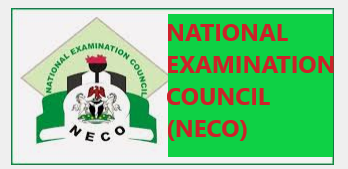
Thanks you
is this the questions and answers scheduled for tomorrow
This is good